英语肯定句变否定句所有规则
- 格式:doc
- 大小:46.00 KB
- 文档页数:13

一、首先,要看肯定句中是否有情态动词,如果有情态动词,直接在情态动词后面加not即可,同时句中如果有some,some就要变成any。
举例如下:1、肯定句:Mike can help you solve the problem.译文:迈克可以帮你解决那个问题。
否定句:Mike can't help you solve the problem. (can't=can not)译文:迈克不能帮你解决那个问题。
2、肯定句:You should lend some money to Mary.译文:你应该借给玛丽一些钱。
否定句:You shouldn't lend any money to Mary. (shouldn't=should not)译文:你不应该借钱给玛丽。
二、如果肯定句中没有情态动词,那就要看句中有无be动词的相应形式,如果有,直接在be动词后面加not,句中有some,some变any。
举例如下:1、肯定句:I am an English teacher.译文:我是一名英语老师。
否定句:I‘m not an English teacher.译文:我不是一名英语老师。
2、肯定句:There are some books on the desk.译文:书桌上有一些书。
否定句:There aren't any books on the desk.译文:书桌上没有书。
三、如果肯定句中既没有情态动词,也没有be动词,那么就要用相应的助动词加上not来变换,句中有some,some变any。
举例如下:1、肯定句:She likes helping others.译文:她喜欢帮助别人。
否定句:She doesn't like helping others.译文:她不喜欢帮助别人。
2、肯定句:They have some apples.译文:他们有一些苹果。
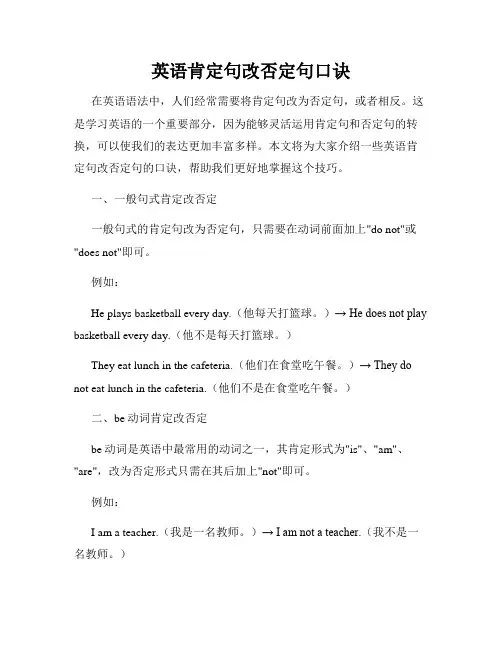
英语肯定句改否定句口诀在英语语法中,人们经常需要将肯定句改为否定句,或者相反。
这是学习英语的一个重要部分,因为能够灵活运用肯定句和否定句的转换,可以使我们的表达更加丰富多样。
本文将为大家介绍一些英语肯定句改否定句的口诀,帮助我们更好地掌握这个技巧。
一、一般句式肯定改否定一般句式的肯定句改为否定句,只需要在动词前面加上"do not"或"does not"即可。
例如:He plays basketball every day.(他每天打篮球。
)→ He does not play basketball every day.(他不是每天打篮球。
)They eat lunch in the cafeteria.(他们在食堂吃午餐。
)→ They do not eat lunch in the cafeteria.(他们不是在食堂吃午餐。
)二、be动词肯定改否定be动词是英语中最常用的动词之一,其肯定形式为"is"、"am"、"are",改为否定形式只需在其后加上"not"即可。
例如:I am a teacher.(我是一名教师。
)→ I am not a teacher.(我不是一名教师。
)They are students.(他们是学生。
)→ They are not students.(他们不是学生。
)三、情态动词肯定改否定情态动词在英语中也占有重要地位,它们有自己的肯定形式和否定形式。
要将肯定形式转化为否定形式,只需在情态动词后面加上"not"即可。
例如:She can swim very well.(她会游泳得很好。
)→ She cannot swim very well.(她游泳不很好。
)You should listen to your parents.(你应该听父母的话。
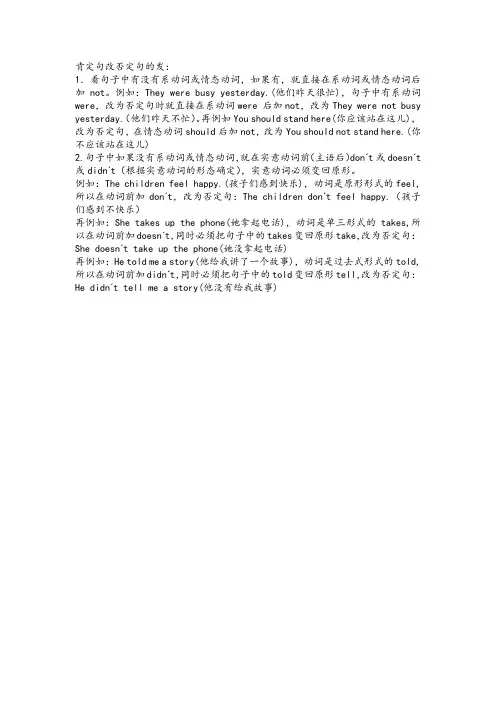
肯定句改否定句的发:
1.看句子中有没有系动词或情态动词,如果有,就直接在系动词或情态动词后加not。
例如:They were busy yesterday.(他们昨天很忙),句子中有系动词were,改为否定句时就直接在系动词were 后加not,改为They were not busy yesterday.(他们昨天不忙)。
再例如You should stand here(你应该站在这儿),改为否定句,在情态动词should后加not,改为You should not stand here.(你不应该站在这儿)
2.句子中如果没有系动词或情态动词,就在实意动词前(主语后)don´t或doesn´t 或didn´t(根据实意动词的形态确定),实意动词必须变回原形。
例如:The children feel happy.(孩子们感到快乐),动词是原形形式的feel,所以在动词前加don´t,改为否定句:The children don´t feel happy.(孩子们感到不快乐)
再例如:She takes up the phone(她拿起电话),动词是单三形式的takes,所以在动词前加doesn´t,同时必须把句子中的takes变回原形take,改为否定句:She doesn´t take up the phone(她没拿起电话)
再例如:He told me a story(他给我讲了一个故事),动词是过去式形式的told,所以在动词前加didn´t,同时必须把句子中的told变回原形tell,改为否定句:He didn´t tell me a story(他没有给我故事)。
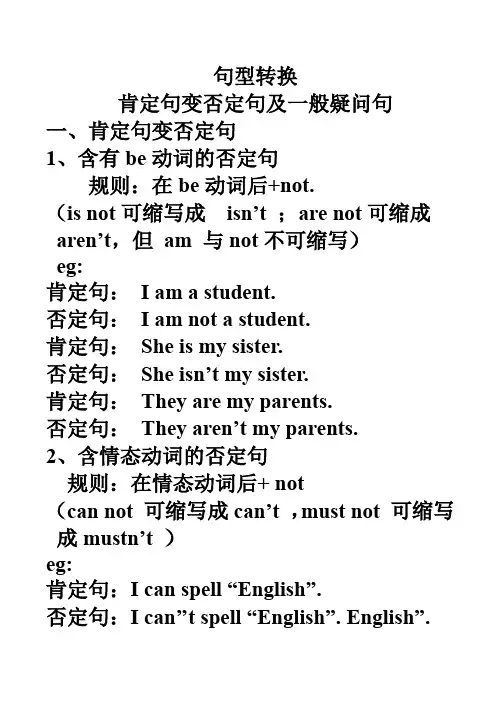
句型转换肯定句变否定句及一般疑问句一、肯定句变否定句1、含有be动词的否定句规则:在be动词后+not.(is not可缩写成isn’t ;are not可缩成aren’t,但am 与not不可缩写)eg:肯定句:I am a student.否定句:I am not a student.肯定句:She is my sister.否定句:She isn’t my sister.肯定句:They are my parents.否定句:They aren’t my parents.2、含情态动词的否定句规则:在情态动词后+ not(can not 可缩写成can’t ,must not 可缩写成mustn’t )eg:肯定句:I can spell “English”.否定句:I can’’t spell “English”.English”.肯定句:I must find it.否定句:I mustn’t find it.3、含有实义动词的句子的否定句构成(1)第三人称单数做主语。
(he、she、it或表示单个人或物的第三人称名词)规则:要在行为动词前加上助动词doesn’t,然后将动词恢复原形。
eg :肯定句:He has a soccer ball.否定句:He doesn’t have a soccer ball.(2)其它人称做主语规则:在行为动词前加don’t ,句子中的行为动词用原形。
eg:肯定句:They like bananas.否定句:They don’t like bananas.注:(1)在变否定句时,如遇some应变any Here are some books.Here aren’t any books.二、肯定句变一般疑问句1、含有be动词的句子变一般疑问句规则:把be动词提至句首,第一人称变第二人称,句末句号变问号。
(I/we变成youMy/our变成your)肯定句:I am a student.一般疑问句:Are you a student?肯定句:She is my sister.一般疑问句:Is she your sister?肯定句:They are my parents.一般疑问句:Are they your parents?2、含有情态动词的句子变一般疑问句规则:把情态动词提至句首,第一人称变第二人称,句末句号变问号。

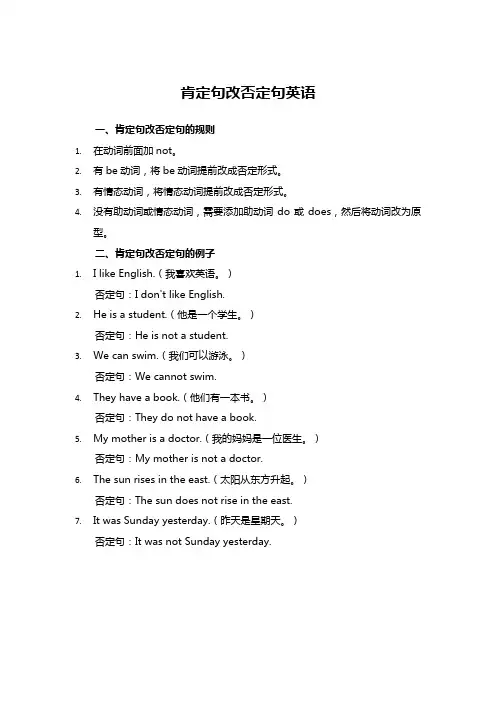
肯定句改否定句英语
一、肯定句改否定句的规则
1.在动词前面加not。
2.有be动词,将be动词提前改成否定形式。
3.有情态动词,将情态动词提前改成否定形式。
4.没有助动词或情态动词,需要添加助动词do或does,然后将动词改为原
型。
二、肯定句改否定句的例子
1.I like English.(我喜欢英语。
)
否定句:I don't like English.
2.He is a student.(他是一个学生。
)
否定句:He is not a student.
3.We can swim.(我们可以游泳。
)
否定句:We cannot swim.
4.They have a book.(他们有一本书。
)
否定句:They do not have a book.
5.My mother is a doctor.(我的妈妈是一位医生。
)
否定句:My mother is not a doctor.
6.The sun rises in the east.(太阳从东方升起。
)
否定句:The sun does not rise in the east.
7.It was Sunday yesterday.(昨天是星期天。
)
否定句:It was not Sunday yesterday.。

英语变否定句的方法1、句中有be动词的,在be动词后加not;2,句中有情态动词的(can ,should,must ,would),在情态动词后面加not;3.句中没有be动词和情态动词的,在动词前加dont或doesnt ;①句中动词为原形的,加dont .如: I like apples. I dont like apples.②句中动词为三单式的,加doesnt,并将三单式的动词还原成原形。
如:He likes apples. He doesnt like apples.4、肯定句中的some在否定句中应改为any如:There are some students in the classroom. There are not any students in the classroom.2特别形式的否定句(1)肯定句含有every-的合成词时,变否定句时改为no-。
如:Everything is ready.Nothing is ready.(2)肯定句中含有always, usually和ever时,变否定句时改为never。
如:He is always late for school.He is never late for school.(3)肯定句含有many,much时,变否定句时分别改为few,little。
如:Many students know him.Few students know him.(4)肯定句中含有still时,变否定句时应改为no longer。
如:Tom is still in bed.Tom is no longer in bed.(5)肯定句含有both, both...and,all时,变否定句时应改为never,neither...nor,none。
如:Both of us are students.Neither of us is a student.(6)肯定句含有nearly, almost时,变否定句时应改为 hardly。

英语语法之肯定句变否定句一、肯定句变否定句口诀给句子分析它,看它结构是哪个主加be后加not 其他一切全照抄主加动词主重要don't doesn’t 来帮忙don’t doesn't 中间夹doesn’t doesn't 最特殊第三人称单数全靠它二、简单句的句子结构1.主语+be+其他2.主语+动词+其他备注:其中be里包括(am is are)判断下列各句是主语加be还是主语加动词1.I am a girl.2.I like singing。
3.We go to school every day.4.They are good friends.5.He works hard.6.She likes playing with toys.7.My mother watches TV every day.8.You are a beautiful girl.9.Tom is playing football on the playground。
10.Bill does his homework after supper。
三、肯定句变否定句规则肯定句主语+be+其他变成主语+be+not+其他主语+动词+其他变成主语+don't+动词+其他主语(第三人称单数)+动词单三+其他变成主语(第三人称单数)+doesn’t +动词原形+其他练习1.She is watching TV now。
2.We go to school on Sunday.3.His father works hard.4.Jack's mother is a nurse.5.The cat runs fast。
6.They like reading books.7.My grandpa gives me a hot dog。
8.Tom often walks to school。
9.I have a doll.10.It is eating fish.。
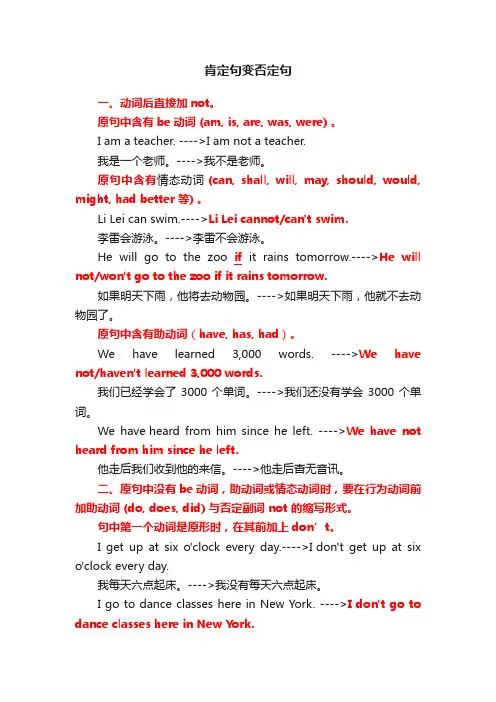
肯定句变否定句一、动词后直接加not。
原句中含有be动词 (am, is, are, was, were) 。
I am a teacher. ---->I am not a teacher.我是一个老师。
---->我不是老师。
原句中含有情态动词 (can, shall, will, may, should, would, might, had better 等) 。
Li Lei can swim.---->Li Lei cannot/can't swim.李雷会游泳。
---->李雷不会游泳。
He will go to the zoo if it rains tomorrow.---->He will not/won't go to the zoo if it rains tomorrow.如果明天下雨,他将去动物园。
---->如果明天下雨,他就不去动物园了。
原句中含有助动词(have, has, had)。
We have learned 3,000 words. ---->We have not/haven't learned 3,000 words.我们已经学会了3000个单词。
---->我们还没有学会3000个单词。
We have heard from him since he left. ---->We have not heard from him since he left.他走后我们收到他的来信。
---->他走后杳无音讯。
二、原句中没有be动词,助动词或情态动词时,要在行为动词前加助动词 (do, does, did) 与否定副词 not 的缩写形式。
句中第一个动词是原形时,在其前加上don’t。
I get up at six o'clock every day.---->I don't get up at six o'clock every day.我每天六点起床。
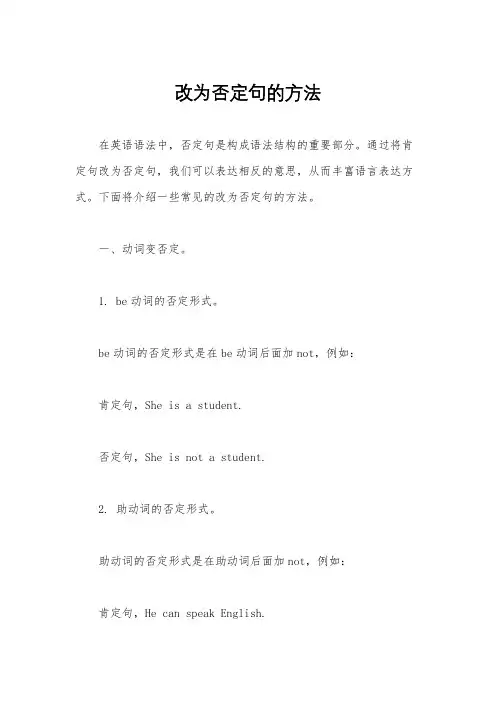
改为否定句的方法在英语语法中,否定句是构成语法结构的重要部分。
通过将肯定句改为否定句,我们可以表达相反的意思,从而丰富语言表达方式。
下面将介绍一些常见的改为否定句的方法。
一、动词变否定。
1. be动词的否定形式。
be动词的否定形式是在be动词后面加not,例如:肯定句,She is a student.否定句,She is not a student.2. 助动词的否定形式。
助动词的否定形式是在助动词后面加not,例如:肯定句,He can speak English.否定句,He cannot speak English.3. 一般动词的否定形式。
一般动词的否定形式是在动词前面加do not或does not,例如:肯定句,They like playing basketball.否定句,They do not like playing basketball.二、副词的否定形式。
有些副词的否定形式是在词前加not,例如:肯定句,She usually goes to work by bus.否定句,She does not usually go to work by bus.三、形容词的否定形式。
形容词的否定形式是在词前加not,例如:肯定句,The movie is interesting.否定句,The movie is not interesting. 四、名词的否定形式。
名词的否定形式是在名词前加no,例如:肯定句,There is a book on the table.否定句,There is no book on the table. 五、句子的否定形式。
句子的否定形式是在句子前面加否定词,例如:肯定句,She will come to the party.否定句,She will not come to the party.六、疑问句的否定形式。
疑问句的否定形式是在疑问句前面加否定词,例如:肯定句,You have finished your homework.否定句,Have you not finished your homework?七、祈使句的否定形式。
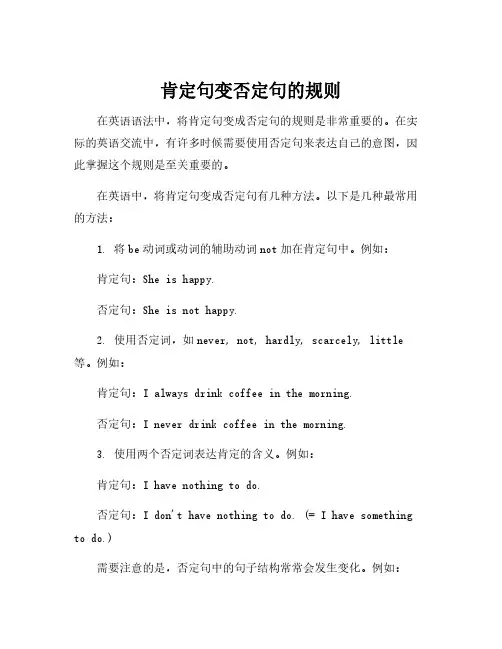
肯定句变否定句的规则在英语语法中,将肯定句变成否定句的规则是非常重要的。
在实际的英语交流中,有许多时候需要使用否定句来表达自己的意图,因此掌握这个规则是至关重要的。
在英语中,将肯定句变成否定句有几种方法。
以下是几种最常用的方法:1.将be动词或动词的辅助动词not加在肯定句中。
例如:肯定句:She is happy.否定句:She is not happy.2.使用否定词,如never,not,hardly,scarcely,little 等。
例如:肯定句:I always drink coffee in the morning.否定句:I never drink coffee in the morning.3.使用两个否定词表达肯定的含义。
例如:肯定句:I have nothing to do.否定句:I don't have nothing to do.(=I have something to do.)需要注意的是,否定句中的句子结构常常会发生变化。
例如:肯定句:He speaks English well.否定句:He does not speak English well.在这个例子中,主语和动词之间插入了动词的辅助动词does。
这是因为在一般现在时和一般过去时中,要使用动词的辅助动词来表示否定意义。
此外,某些词语的否定形式也要格外留意。
例如:肯定句:I have some money.否定句:I have no money.肯定句:There is a book on the desk.否定句:There is no book on the desk.总之,在学习英语语法时,将肯定句变成否定句的规则是必不可少的一部分。
只有熟练地掌握了这些规则,才能在实际的英语交流中更自如地表达自己的意图。
英语肯定句改否定句口诀摘要:一、英语肯定句改否定句的规则1.规则概述2.注意事项二、口诀及其解释1.口诀内容2.口诀解释三、实例解析1.一般现在时2.一般过去时3.一般将来时4.现在进行时5.过去进行时6.将来进行时7.现在完成时8.过去完成时9.将来完成时10.现在完成进行时11.过去完成进行时12.将来完成进行时正文:英语肯定句改否定句是英语语法中的一个重要环节,掌握好这个规则对于英语学习者来说非常关键。
下面,我们通过一个口诀来帮助大家更好地理解和运用这个规则。
一、英语肯定句改否定句的规则1.规则概述在英语中,将肯定句改为否定句主要遵循以下三种规则:(1)在动词前加not(2)借助助动词do, does, did(3)借助助动词have, has, had2.注意事项(1)注意保持时态的一致性(2)注意主语的一致性二、口诀及其解释1.口诀内容“没有(no)要助(do)动,有(yes)要主(have)动。
”2.口诀解释这个口诀简洁明了地概括了英语肯定句改否定句的规则。
当我们需要将一个肯定句改为否定句时,可以根据情况选择使用“没有要助动”或“有要主动”的方法。
三、实例解析以下是一些英语时态的实例,展示了如何将肯定句改为否定句:1.一般现在时肯定句:I study English every day.否定句:I do not study English every day.2.一般过去时肯定句:I studied English yesterday.否定句:I did not study English yesterday.3.一般将来时肯定句:I will study English tomorrow.否定句:I will not study English tomorrow.4.现在进行时肯定句:I am studying English now.否定句:I am not studying English now. 5.过去进行时肯定句:I was studying English then.否定句:I was not studying English then.6.将来进行时肯定句:I will be studying English then.否定句:I will not be studying English then.7.现在完成时肯定句:I have studied English.否定句:I have not studied English.8.过去完成时肯定句:I had studied English.否定句:I had not studied English.9.将来完成时肯定句:I will have studied English.否定句:I will not have studied English.10.现在完成进行时肯定句:I have been studying English.否定句:I have not been studying English.11.过去完成进行时肯定句:I had been studying English.否定句:I had not been studying English.12.将来完成进行时肯定句:I will have been studying English.否定句:I will not have been studying English.通过以上实例和口诀,相信大家对英语肯定句改否定句的规则已经有了更深入的了解。
英语肯定句改为否定句的方法
将英语肯定句改为否定句,需要遵循以下步骤:
1. 找到句中的动词。
2. 如果动词是be动词(即am, is, are),直接在其后加not。
3. 如果动词是助动词(即do, does, did),在其后加not。
4. 如果动词是实意动词,则需要借助助动词do, does, did,在其后加not。
5. 如果有情态动词(如must, can等),则在情态动词后加not。
6. 如果有否定词如never、no等,则不需要再加否定词。
7. 如果有already、yet等副词,需要变为yet或still。
8. 如果有some,需要变为any。
以下是一些具体的例子:
1. 肯定句:I am a student.
否定句:I am not a student.
2. 肯定句:She does her homework every day.
否定句:She doesn't do her homework every day.
3. 肯定句:He has a cat.
否定句:He doesn't have a cat.
4. 肯定句:They will come here.
否定句:They won't come here.
5. 肯定句:We must finish our work today. 否定句:We must not finish our work today.。
英语肯定句改否定句口诀
摘要:
1.英语肯定句的基本结构
2.如何将肯定句改为否定句
3.英语否定句的构成
4.口诀记忆法
正文:
一、英语肯定句的基本结构
英语肯定句的基本结构是:“主语+ 谓语+ 宾语”,例如:“I love you”。
在这个结构中,主语是执行动作的人或事物,谓语表示动作,宾语则表示动作的承受者。
二、如何将肯定句改为否定句
要将肯定句改为否定句,需要在谓语动词前加上助动词“do”的相应形式,同时将动词变为原形的否定形式。
例如,将“I love you”改为否定句,可以这样操作:“Do I love you?”→“I don"t love you”。
三、英语否定句的构成
英语否定句的基本结构是:“主语+ 助动词(do 的适当形式)+ 动词(原形的否定形式)+ 宾语”,例如:“I don"t love you”。
四、口诀记忆法
为了方便记忆,我们可以用一个口诀来帮助记忆:“肯定句变否定,助动词来帮忙,前加do 后变no,否定句便完成”。
这个口诀的意思是:要将肯定句
改为否定句,先在谓语动词前加上助动词“do”,然后将动词变为原形的否定形式(即在动词前加“no”)。
这样,一个否定句就完成了。
通过以上讲解,相信大家已经了解了如何将英语肯定句改为否定句。
英语肯定句改为否定句口诀
以下是一些常见的英语肯定句改为否定句的口诀,帮助您快速掌握。
1.一般现在时
-肯定句:主语+动词原形
-否定句:主语+do/does not+动词原形
2.一般过去时
-肯定句:主语+动词过去式
-否定句:主语+did not+动词原形
3.一般将来时
-肯定句:主语+will+动词原形
-否定句:主语+will not/won't+动词原形
4.现在进行时
-肯定句:主语+am/is/are+动词-ing形式
-否定句:主语+am/is/are not+动词-ing形式
5.现在完成时
-肯定句:主语+have/has+过去分词
-否定句:主语+have/has not+过去分词
6.过去进行时
-肯定句:主语+was/were+动词-ing形式
-否定句:主语+was/were not+动词-ing形式
7.过去完成时
-肯定句:主语+had+过去分词
-否定句:主语+had not+过去分词
8.情态动词
-肯定句:主语+情态动词+动词原形
-否定句:主语+情态动词+not+动词原形
9.be动词(一般现在时)
-肯定句:主语+am/is/are
-否定句:主语+am/is/are not
10.be动词(一般过去时)
-肯定句:主语+was/were
-否定句:主语+was/were not
这些口诀可以帮助您快速记住肯定句改为否定句的基本规则。
然而,需要注意的是,有些特殊情况下,否定形式可能会有其他变化或使用不同的词汇。
因此,在具体应用时,仍需结合具体语境和语法规则进行判断和运用。
一、简单句中含有be动词、情态动词和助动词时,变否定句时需在be动词、情态动词和助动词后加not。
1. (am, is ,are 是be动词)如:I am a teacher.→I am nota teacher.This is a pen.→ This is not a pen.或This isn’t a pen. (is not =isn’t) You are a boy. →You are not a boy. (are not =aren’t)2. (can是情态动词)He can help me.→He can not help me.或He can’t help me.(can not =can’t )3.当主语是第一人称、第二人称和第三人称复数时用助动词do,变否定时,在do后面加not 如:I like English .I do not like English.或I don’t like English.They go to school together. →They do not (don’t) go to school together.4.当主语是第三人称单数时用does,变否定时,在does后面加not,如:The little girl wants to go there.→ The little girl does not (doesn't ) want to go there.2.简单句中谓语动词为行为动词时,要根据时态选用do的相应形式,把肯定句变为否定句。
如:The little girl wants to go there.→The little girl doesn't want to go there.He did his work yesterday.→He didn't do his work yesterday.3.祈使句变否定句时,一般在句首加Don't,但Let us或Let's 开头的祈使句在Let us或Let's后加not也可。
英语肯定句改否定句口诀摘要:1.英语肯定句改否定句的规则2.缩写和助动词的使用3.实例分析正文:一、英语肯定句改否定句的规则在英语中,将肯定句改为否定句有一定的规律可循。
首先,我们需要找到句子中的助动词,例如:is, are, do, did, have, has, will, can 等。
然后,按照以下规则进行转换:1.在助动词前加not,形成not + 助动词的结构。
2.如果句子中没有助动词,需要添加一个助动词do,并在其前加not,形成not + do + 主语的结构。
二、缩写和助动词的使用在实际操作中,我们可以使用缩写和助动词来简化这个过程。
以下是一些常用的缩写和助动词:1.is -> isn"t2.are -> aren"t3.do -> don"t/doesn"t/didn"t4.have -> haven"t/hasn"t5.will -> won"t6.can -> can"t三、实例分析下面我们通过一些实例来具体分析如何使用这些规则:1.肯定句:I am a student.否定句:I am not a student.(直接在am 前加not)2.肯定句:She has a book.否定句:She has not a book.(添加助动词do,并在其前加not)3.肯定句:He will go to the park.否定句:He will not go to the park.(直接在will 前加not)4.肯定句:They can swim.否定句:They cannot swim.(添加助动词can,并在其前加not)通过以上实例,我们可以看出英语肯定句改否定句的方法和规律。
一、简单句中含有be动词、情态动词和助动词时,变否定句时需在be动词、情态动词和助动词后加not。
1. (am, is ,are 是be动词)如:I am a teacher.→I am nota teacher.This is a pen.→ This is not a pen.或This isn’t a pen. (is not =isn’t) You are a boy. →You are not a boy. (are not =aren’t)2. (can是情态动词)He can help me.→He can not help me.或He can’t help me.(can not =can’t )3.当主语是第一人称、第二人称和第三人称复数时用助动词do,变否定时,在do后面加not 如:I like English .I do not like English.或I don’t like English.They go to school together. →They do not (don’t) go to school together.4.当主语是第三人称单数时用does,变否定时,在does后面加not,如:The little girl wants to go there.→ The little girl does not (doesn't ) want to go there.2.简单句中谓语动词为行为动词时,要根据时态选用do的相应形式,把肯定句变为否定句。
如:The little girl wants to go there.→The littl e girl doesn't want to go there.He did his work yesterday.→He didn't do his workyesterday.3.祈使句变否定句时,一般在句首加Don't,但Let us或Let's 开头的祈使句在Let us或Let's后加not也可。
如:Put them over there.→Don't put them over there.Let us go home.→Let us not go h ome.或Don’t let us go home.4.主从复合句中,主句是I think,I believe等结构,变否定句时,形式上否定主句,实际上否定从句。
如:I don't think chickens can swim .我认为鸡不会游泳。
5.“had bette r +动词原形”,变否定句时为“had bette r not +动词原形”。
如:You'd better go to school.→ You'd better not go to school.6.动词不定式变否定式时,常在不定式to前加not。
如:The teacher tells me to do it.→ The teacher tells me not to do it.7.使役动词和感官动词(make,let,hear,see,watch等)后接省略to的不定式,此种不定式变否定句时只需在省略to 的动词原形前加not。
如:I saw her work.→I saw her not work.8.特殊形式的否定句,有以下几种:(1)肯定句含有every-的合成词时,变否定句时改为no-。
如:Everything is ready.→Nothing is ready.(2)肯定句中含有always,usually和ever时,变否定句时改为never。
如:He is always late for school.→He is never late for school.(3)肯定句含有many,much时,变否定句时分别改为few,little。
如:Many students know him.→Few students know him.(4)肯定句中含有still时,变否定句时应改为no longer。
如:Tom is still in bed.→Tom is no longer in bed.(5)肯定句含有both,both...and,all时,变否定句时应改为never,neither...nor,none。
如:Both of us are students.→Neither of us is a student.(6)肯定句含有nearly,almost时,变否定句时应改为hardly。
如:Lily nearly knows him .→Lily hardly knows him .(7)肯定句含有“形容词+enoug h”时,变为否定句时应改为“too +形容词的反义词”。
如:He is short enough to reachit.He is too tall to reach it.(1)谓语动词是be,have(有)或谓语含有助动词、情态动词时,直接在这些词后加上否定词not。
如:She can swim.She can't swim.(2)谓语动词是行为动词时,要在该动词前加上do /does /did not,该词恢复原形。
如:He gets up early.He doesn't get up early.(3)既要否定谓语动词,又要变换句中的单词。
如:He can read and write.He can't read or write.(4)用含否定意义的词或词组取代肯定句中的某些词或词组。
如:I know both English and Chi- nese.I know neither English nor Chinese.类似的有:ever /always never,somebody nobody,something nothing,everybody no one,almost hardly 2.祈使句的肯定式变否定式(1)一般在动词前加上don't。
如:Open the window .Don't open the window.(2)含有“Let's...”的祈使句,一般用“Let'snot...”的形式,美国人偶尔也用“Don'tlet's...”这一形式。
加强语气时使用“Let'sdon't...”这一形式。
如:Let's go there.Let's not go there.3.复合句的肯定式变否定式一般将主句变为否定式。
如:I saw her when I left .I didn't see her when I left.肯定句改为否定句的基本方法把肯定的陈述句改为否定句的基本方法首先要掌握否定句构成的基本规则。
①当陈述句的谓语动词由be构成时,改为否定句,把not 加在be后面。
例1.They are doctors.这个句子的谓语动词是由系动词构成的,改为否定句时把not加在are的后面,即:They are not doctors.例2.He is g oing to see his friend tomorrow.本句的谓语由is going to see构成,改为否定句时把否定词not 加在is后面,即:He is not going to see his friend tomorrow.②当陈述句的谓语由情态动词can(may,must等)+其他动词构成,或由助动词will,have,had等十其他动词构成时,改为否定句,用情态动词或助动词十not+动词的形式表示。
例3.They will go to see their parents this afternoon.这个句子谓语由助动词 will加动词g o构成,改为否定句时,把not放在will后面,即:They will not(won't)go to see their parents this afternoon.例4.The train had already left when we got to the station.这个句子谓语由助动词had加leave的过去分词left构成,改为否定句时要把not加在had后面,同时already改为yet,即:The train had not left yet when we got to the station.例5.Linda can speak Chinese well.本句的谓语由can+speak构成,把它改为否定句时,在can 后面加not,即:Linda can not speak Chinese well.例6.We have already learned English for two years.本句的谓语由have+learned构成,把它改为否定句时,要在助动词have后面加not,把句中的already改为yet,即:We have not learned English for two years yet.③当陈述句的谓语动词是have,表示有什么,改为否定句的方法是:(A)由have+not+其他;(B)由have十no十其他;(C)由don't(doesn't,didn't)+have十其他,如果句中有some,要将some改为any。
例7.You have some books.这个句子谓语动词have当“有”讲,在改为否定句时要把not 放在have后,并把some改为any,即:You have not any books.这个句子也可以改写为在have后加no即:You have no books.这个句子还可以改写为:You don't have any books.④当陈述句的谓语由have十其他词构成,这时have不当“有”讲,也不是“助动词”,改为否定句时,由助动词do(does,did)+not+have构成否定结构。
例8.They often have breakfast at seven in the morning.本句的谓语动词是have,而have+breakfast的意思是“吃早饭”,把它改为否定句,要由助动词do+not+have breakfast 构成否定形式,即:They don't have breakfast at seven in the morning.例9.He had a meeting yesterday afternoon.本句谓语动词had+meeting的意思是“开会”,是一般过去时,改为否定句时由did not+have a meeting构成否定形式,即:He didn't have a meeting yesterday afternoon.●以上两个例句说明改成否定句时,千万不要盲目把否定词加在have(has,had)后面。